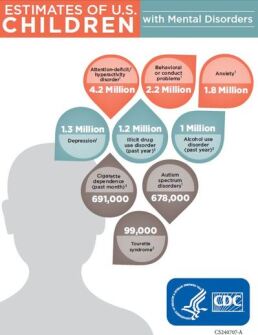Millions of American children live with depression, anxiety, attention deficit hyperactivity disorder, autism spectrum disorders, Tourette syndrome or a host of other mental health issues, the Centers for Disease Control and Prevention note in a new report.
The agency says this is the first-ever report to describe federal efforts to monitor mental disorders in children. It provides estimates of the number of children ages 3 to 17 with mental health disorders from 2005 to 2011. In all, the agency said, 13 percent to 20 percent of U.S. children experience a mental disorder in a given year.

The CDC notes (perhaps obviously) that for some kids, a mental health disorder can result in serious difficulties at home, with peers, and at school and can be associated with substance use, criminal behavior, and other risky behaviors. An estimated 40 percent of children with one mental disorder have at least one other mental health disorder, and they are more likely to have other chronic health conditions such as asthma, diabetes, and epilepsy. And of course, childhood mental health problems are associated with an increased risk for adult mental health problems.
Some of the other findings are stark and downright hard to read.
For example, it says that suicide, which can result from the combination of mental disorders and other factors, was the second leading cause of death among children ages 12-17 years in 2010.
And in the United States, the cost of mental disorders for people younger than 24 is estimated to be $247 billion a year. That includes health care, services including special education and juvenile justice, and decreased productivity.
All things mental health have been in the spotlight since the December shootings in Newtown, Conn., where a gunman killed 26 students and staff members—the deadliest K-12 shooting in American history. The Obama administration has pledged to address mental health care along with other measures as part of a host of proposals to prevent school violence in the future.
Interestingly, while there apparently isn’t a sufficient supply of mental health services, as I have written about and as many mental health professionals have said over and over again in the five months since the Newtown shootings, perhaps more people are seeking out the services that are available: The CDC report says two recent studies show substantial increases in the use of services for mental disorders among children.
Some of the stats (See the graphic embedded in this post for even more numbers.):
- The most common disorder: ADHD. Pulling data from a number of sources, about 8 percent of children are estimated to have ADHD. (That’s a little different than a recent analysis of CDC data that about 11 percent of U.S. kids have ADHD.)
- Boys were more likely than girls to have ADHD, behavioral or conduct problems, autism spectrum disorders, anxiety, Tourette syndrome, and cigarette dependence while adolescent girls were more likely than adolescent boys to have depression or an alcohol-use disorder.
- After ADHD, the prevalence of mental health diagnoses, in descending order, is behavioral or conduct problems, anxiety, depression, autism spectrum disorders, and Tourette syndrome.
- In addition, an estimated 4.7 percent of kids ages 12 to 17 reported an illicit drug use disorder in the past year, 4.2 percent had an alcohol abuse disorder in the past year, and 2.8 percent were dependent on cigarettes.
The CDC said all of this monitoring is “a critical first step in the public health approach to mental health among children,” and can help “identify need and target resources at the national, state, and local levels.”